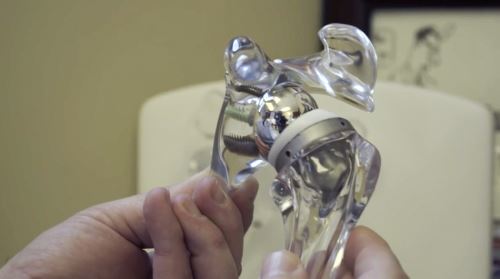
Open Accessibility Menu
Hide
dfh
Close Alert
Close Alert
What is a Reverse Total Shoulder Replacement?
Author: John G. Costouros, MD

The shoulder is the most complex joint in the human body. The dynamic interplay of bones, muscles and tendons, while allowing for greatest range of motion of any joint in the human body, also makes it uniquely susceptible to injury. Over time, the pain and diminished motion that these types of injuries cause can seriously affect one’s quality of life.
While many shoulder issues can be treated with nonsurgical methods like medications, physical therapy or injections, shoulder surgeries are increasingly common and able to provide predictable outcomes and durable results. In fact, there are many procedures available that use arthroscopic techniques in which a small incision is made and a tiny high-definition camera is used with specialized instruments to guide the surgeon through minimally-invasive surgery. Because they’re less invasive, there’s typically less postoperative pain and bleeding, more cosmetic incisions which are barely visible, shorter surgical times, lower risk of infection, and faster recovery. These are also outpatient procedures, allowing patients to go home on the same day as surgery.
However, when a shoulder joint has degenerated to the point it needs to be replaced, patients can opt for a total shoulder replacement or reverse total shoulder replacement.
While both the total shoulder replacement and reverse total shoulder replacement involve replacing the surfaces of the shoulder joint with prosthetic components made of metal and plastic, the difference is how these prostheses are configured.
Your shoulder joint consists of a ball and socket. The ball (or humeral head) is part of your arm bone (humerus), and rests in the socket portion of your shoulder blade (glenoid). With a reverse prosthesis, the ball is placed on the shoulder blade side of your joint, while the socket is on the arm side – a reversal of your normal anatomy. This changes the mechanics of the shoulder and allows the deltoid muscle to power the arm overhead. Reverse shoulder replacement concept has been used successfully around the world for over 30 years and was FDA-approved for use in the United States in 2004.
Sometimes, the muscles and tendons of the rotator cuff within the shoulder are so damaged that a standard total shoulder replacement won’t perform well. This can lead to poor motion and loosening of the components. When these tendons are torn to the point they no longer attach to bone, a person will be unable to lift their arm overhead, out to the side, or reach behind their back. This adversely affects quality of life.
Because it doesn’t rely on the tendons and muscles of the rotator cuff, a reverse prosthesis offers the best chance of restoring use of the arm and range of motion.
Surgery and recovery time depend largely on whether it’s the first shoulder replacement (primary) or if there is an existing prosthesis that needs to be removed and replaced (revision).
For all shoulder procedures, a nerve block is done followed by a general anesthetic. An incision is made in the front of the shoulder through which the deteriorated shoulder joint is removed. Typically, this type of procedure takes less than an hour in the hands of an experienced shoulder specialist.
While a patient may begin some elbow, wrist, and hand motion immediately following surgery, movement of the shoulder may be limited for a few days to a few weeks. Physical therapy is a crucial part of obtaining the best possible outcome following shoulder replacement surgery. Relief of pain is rapid following shoulder replacement and return of range of motion is more gradual as patients progress through their formal physical therapy and exercises.
As one of the first surgeons to bring reverse shoulder replacement to the U.S., I’ve seen how this procedure can change lives and treat a wide spectrum of complex shoulder problems. Now, 16 years later, I’ve had the privilege of participating in several clinical trials to refine this and other shoulder procedures, as well as helped with the development of better prostheses and implants that are currently in use.
I decided to join Washington Hospital’s Institute for Joint Restoration and Research in order to bring shoulder joint replacement surgery to a place that has set the bar so high for patient outcomes and quality of care. I wanted my skills and expertise to be part of that. Building on the successes of the hip and knee replacement specialties pioneered at the IJRR, we’re now able to add total shoulder replacement and reverse total shoulder replacement to our advanced surgical offerings.
Learn more about how education and specialization are improving quality of life for our patients, with this video on the Institute for Joint Restoration and Research.
Posted March, 2020